Spider Basics: How Spiders Eat

Slurping Up The Goodness
I haven't done a good spider post in a while, and since this is the Infinite Spider Blog I do feel this need to keep up. I've written about spider feet, how spider legs work, spider eyes, orange and black spiders, fishing spiders, and brown spiders but what I haven't covered is how spiders eat. There are two answers to this question, and the answer depends on how the spider gets it food.
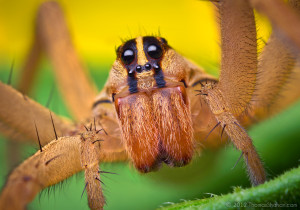
There are two general groups of spiders, the wandering or hunting spiders and the web building spiders. The anatomy of both groups is similar, because they are all arachnids with two body segments, with a fused head-thorx called a cephalothorax and an abdomen as well as eight legs. Both types can create silk, but the wandering spiders usually use the silk for drag lines (like bungee cords), wrapping eggs, or creating tunnels. Both types of spiders also have multiple eyes, but the arrangement of these eyes is different. Wandering spiders tend to have two large eyes, and several smaller ones arranged around them. Orb weaving spiders tend to have have rows of only tiny eyes, because they rely on touch and vibrations more than eyesight, whereas hunting spiders actively hunt and jump on their prey at night (this is why when you turn on the kitchen light in the middle of the night you see them scurry off, they were hunting).

So what does all this have to do with how spiders eat? It has to do with how the spider captures and subdues its prey as well as how it chooses to slurp its soup. First, let's look at a quick chart to help compare the two types of spiders:
Wandering Spiders |
Web Building Spiders |
| Many eyes, two large ones, good eyesight | Many eyes, all tiny, poor eyesight |
| Legs are hairy with airy pads for traction and web walking | Legs are hairy with three hooks for hanging on web strands |
| Search for and hunt for prey | Wait for prey |
| Powerful jaws | Weak jaws |
| Thicker and more powerful legs for jumping on prey | Thinner and more agile legs |
| Fangs usually up and down, serrated | Fangs more horizontal, not always serrated |
Web building spiders are agile and patient. They wait for their food by hanging on the webs they build, and they don't rely on eyesight to find their prey. Wandering spiders have good eyesight, strong muscular legs and they have modified and padded feet that allow them to climb walls, run quickly, and jump on prey.
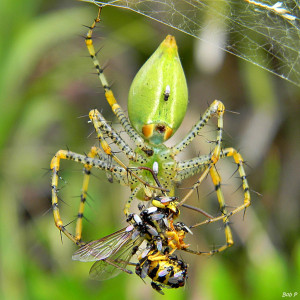
Another large difference is how they subdue and consume their prey. Remember, spiders don't have true teeth, instead the have fangs which inject venom. Venom is made in their salivary glands and is delivered through their hollow pointy bits on the ends. Most spider venom is specifically made to be toxic to arthropods (insects and other spiders), which makes sense because that's the majority of their prey.
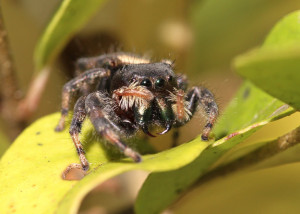
Spider venom is usually stored stored in the chelicerae (mouth parts) in "pieces," sort of like a baking recipe, in the glands of the spider. If the venom was pre-made and sitting around in their glands it could poison them, after all they are arthropods too. Spiders can put together these "pieces" of the recipe to made one more types of venom, which also makes sense considering that they use the venom for defense, subduing and digesting their prey. Some venom may be a neurotoxin while other venoms may be cytotoxins that breaks down cell walls and tissues or even digestive enzymes. You can read all about spider venom in this article by Ron Atkinson.
Now, lets get to the feeding bit. Since spiders don't have teeth they live on a liquid diet. How they get that liquid varies. Most hunting spiders (and some web building spiders) have serrated chelicerae. These serrated mouth parts work best when they prey is against the ground (or other hard surface) and the mouth parts can move back and forth to tear apart and shred their food (thus the need for for venom that can break down cell walls). Check out this neat page from OSU for some interesting images.
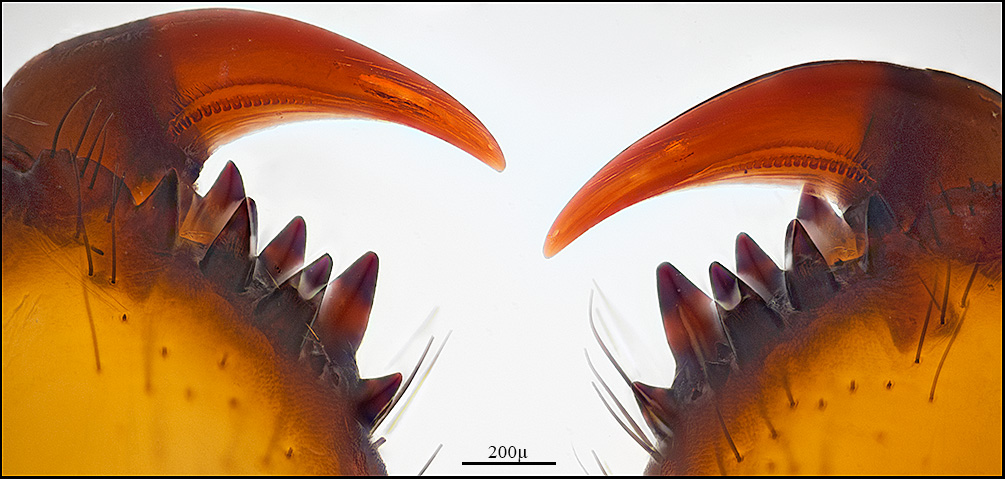
This is also why most hunting spiders have vertical mouth parts that move up and down and can create a mushy prey bolus. Web building spiders don't always have the advantage of being able to hold their prey against a hard surface, so they may lack the serrated chelicerae. Regardless, both groups use injected venom to liquefy their prey. Hunting spiders may spit the enzymes on the prey bolus and then let it work for a bit. Web builders may wrap up their prey and then inject it and let the prey liquefy in its own cocoon sippy cup. Hunting spiders sometimes do this too, they wrap up their prey and carry it off as a prize for their mate, or young, and then drink it down after its had a bit of time to crock-pot in some enzymes.
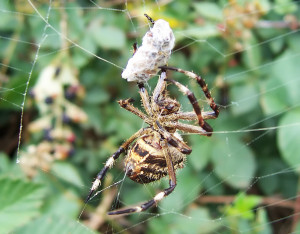
All spiders have a type of stomach that is called a "sucking stomach" (this is not like humans sucking in their stomach to look thinner). The sucking stomach literally creates a sucking motion to draw in the liquefied prey remains, whether it's the spit--slurp--n'--sip of the hunting spiders or the wrap--inject--and sip of the web builders.
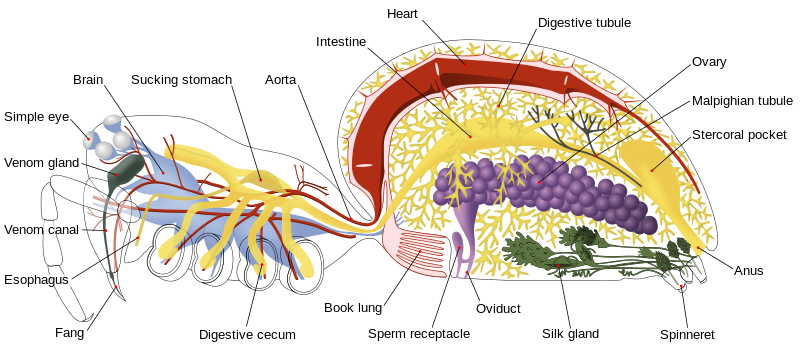
Spiders have a foregut where food can be stored, and a hind gut where more digestion occurs. It's also thought that they can spit enzymes back and forth from their sucking stomach, through their mouth, and suck it back in, sort of like a deer chewing cud, but in this case it's re-using digestive enzymes instead of a grass ball that is being chewed on.
The sucking stomach attaches to the spider's intestine, and at the mid-intestine a storage area is formed from a series of canals or tubes that extend outward in a in wagon wheel, or spoke-like formation, called the caecal (sea-cal) ring (on the picture above it's called the digestive cecum...caecum and you shall find um). You can actually see this when you look cephalothorax of some spiders, like this one below. This wolf spider has clear markings in the "spoke" and wagon wheel formation. If you could "pop-the-hood" and look underneath, you'd see this corresponds with the caecal ring.
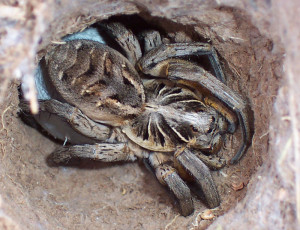
While eating many spiders also have the ability to expand their abdomen, like your belly expands after a big Thanksgiving dinner. You can sometimes tell when a spider has fed by looking at the expansion of their abdomen, especially in tarantulas.
Although it's disgusting to most people, I think how spiders eat is pretty unique and fascinating. They are perfectly designed for their tiny world, and their feeding methods lend to us pest control and keeping the insect populations in check. Next time you see a spider web, or a hunting spider feeding, take a closer look and see if you can observe them doing their spider-slurp-n'-sip feeding methods.


